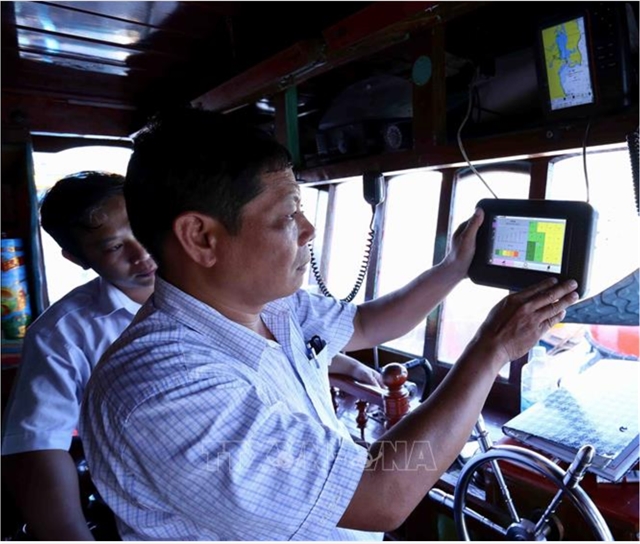 Society
Society

 |
| An officer of the Directorate of Fisheries checks the vessel monitoring system (VMS) on a fishing vessel in Quy Nhơn Port. VNA/VNS Photo |
HÀ NỘI – The installation of a vessel monitoring system (VMS) on fishing vessels with a length of 15m or more has made progress and reached 93.4 per cent as of June 30, according to the Directorate of Fisheries.
Quảng Ninh, Thừa Thiên-Huế, Ninh Bình and Cà Mau are four out of 28 coastal provinces nationwide completing the VMS installation on all fishing vessels, the directorate said.
But many localities have a rate of VMS installation lower than the national average, such as Quảng Trị with 79.02 per cent, Trà Vinh - with 84.79 per cent, Quảng Ngãi - with 86.68 per cent, and Nghệ An 87.31 per cent.
According to the directorate, there was a situation in which many localities could not control the number of fishing vessels that had not yet been equipped with the VMS, leading to illegal fishing.
Among the 102 fishing vessels seized by foreign countries from the beginning of 2021 up to now, only 43 vessels were installed with VMS.
In addition, the supervision and use of the VMS on fishing vessels still lack synchronisation.
Only 20 out of 28 provinces and cities currently organise 24-hour supervision duty.
The connection between the VMS and control centres has exposed shortcomings. There was a fact that vessels still lost contact for more than 10 days at sea.
Installing VMS equipment on fishing boats is one of the decisive solutions to end illegal, unreported and unregulated (IUU) fishing practices, particularly the illegal fishing in foreign waters.
Towards the goal of having the European Commission's "yellow card" on IUU removed, the directorate's deputy director general, Nguyễn Quang Hùng, urged the administrations of coastal localities to speed up the installation of VMS equipment and effectively use the equipment to monitor the operation of their fishing fleets at sea closely.
He also asked localities to coordinate with each other to monitor and timely handle law violations of fishing boats.
Coastal provinces shall input fishing vessel data into the national fisheries database according to regulations to meet the requirements of information retrieval and management of fishing vessels entering and leaving fishing ports.
The authorities have to strictly implement the regulations on controlling fishing vessels entering and leaving ports, monitoring fishery output from fishing, and tracing the origin of aquatic products.
Localities have to promote information dissemination and training on recording and submitting reports and fishing logs ensuring to match the itineraries recorded by VMS.
Relevant offices should also provide training courses for staff in charge of inspecting and controlling fishing vessels entering and leaving ports, monitoring seafood output through ports and handling cases of IUU fishing.
The provinces and cities shall monitor and make a list of fishing vessels at high risk of violating IUU fishing and resolutely handle IUU fishing violations in terms of reports and fishing logs, fishing licences, VMS installation and use, fishing in wrong areas, and crossing the boundary outside of VMS monitoring.
In addition, localities also have to work closely to monitor, control and handle fishing vessels of the province operating in other provinces to prevent and promptly address IUU fishing. VNS




